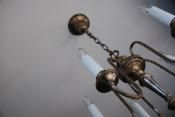 Electrical shocks are no laughing matter. They can kill. The Canadian Standards Association (CSA) publishes more than 700 standards related to electrical products. From fuses to refrigerators, many of these codes are designed to improve safety in the home. Chief amongst these is the Canadian Electrical Code (CE Code), which published its 21st edition in early 2009. Read our electrical saftey tips below.
Electrical shocks are no laughing matter. They can kill. The Canadian Standards Association (CSA) publishes more than 700 standards related to electrical products. From fuses to refrigerators, many of these codes are designed to improve safety in the home. Chief amongst these is the Canadian Electrical Code (CE Code), which published its 21st edition in early 2009. Read our electrical saftey tips below.
- Do not use a crib made before 1986. Check the label on your child’s crib to see how old it is. If your crib does not have a label, or is homemade, it may not be safe to use.
- Be sure that the space between crib bars is no more than 6 centimetres or 2-3/8 inches.
- Choose a crib where the part supporting the mattress is attached permanently to the crib frame. It should not be attached by S-shaped or Z-shaped hooks.
- Do not use a crib that has any corner posts that could catch on your child’s clothing.
- Do not buy a crib that has loose, missing or broken parts.
- Make sure the mattress in the crib is firm and no more than 15 centimetres or 6 inches thick.
- Make sure the mattress fits tightly against all 4 sides of the crib. If you can fit more than one finger between the mattress and each side of the crib, the mattress is too small. Babies can get wedged between the mattress and the side of the crib.
Safety tips for using cribs:
- Always lock the sides of the crib in the upright position after placing your baby in it.
- Keep your baby’s crib away from windows, curtain or blind cords. Children can fall out of the window or get caught in curtain or blind cords.
- Do not put large stuffed toys, pillows, bumper pads and thick comforters into your baby’s crib. These items can suffocate your baby.
- Make sure your baby does not have a bib, necklace, or anything tied around his or her neck when in the crib. These items could get caught on parts of the crib and strangle your baby.
- As soon as your baby can push up on his hands or knees, remove toys strung across the crib. Your baby can become caught in these toys and strangle.
- When your child is about 90 centimetres or 35 inches tall, he or she can climb out of the crib. This is the time to move your child from the crib into a low bed.

